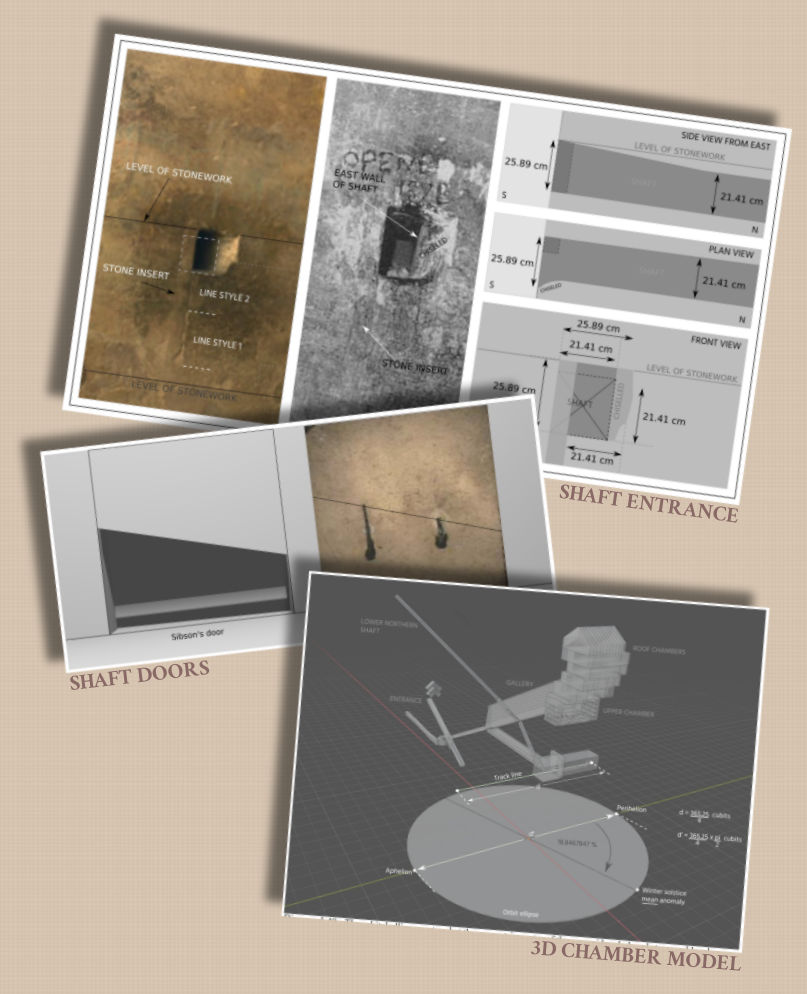THE GREAT PYRAMID PAPERS
The Solar System Model
PAPER U
March 2024
NEW
PAPER T
March 2024
NEW
PAPER S
March 2024
NEW
PAPER R
March 2024
NEW
PAPER Q
March 2024
NEW
PAPER P
March 2024
NEW
PAPER O
March 2024
NEW
PAPER N
September 2023
PAPER M
September 2023
The Giza Plateau
PAPER L
March 2023
PAPER K
December 2022
PAPER J
April 2022
The Great Pyramid
PAPER I
December 2021
PAPER H
April 2021
PAPER G
April 2021
PAPER F
April 2021
PAPER E
April 2021
PAPER D
April 2021
PAPER C
April 2021
PAPER B
April 2021
PAPER A
September 2020
BOOK 1
August 2010
Home Page
INDEX
The architecture of the Great Pyramid's lower northern shaft
- The origin of the metal rods
- The stone ball
- The exact shaft angle
- Axial tilt of Earth
- Dating the pyramid to 2729 BCE
ABSTRACT
In the summer of 2021 a series of static images which were taken in 2002 inside the lower northern shaft of
the Great Pyramid of Giza were released to the public. In this paper I analyse those images and from that
analysis deduce the linear and angular construction parameters of the shaft. I show that the shaft contains a
series of rotations around its longitudinal axis which conform to a logical system and that this logical
system can be used to extract mathematically precise angular measurements because the system uses
known geometric principles.
From the analysis of the shaft's design I show that the metal rods that are located inside the shaft are an original part of the pyramid's construction and explain how one of the two rods was used as a spring mechanism to release a side door within the shaft, behind which was contained a 7cm diameter stone ball that rolled out of the shaft in 1872. Furthermore I explain how the act of investigating this shaft by poking rods up the shaft's incline triggered this spring mechanism to operate.
By using the geometric angles derived from the shaft's construction I show that the stone ball is a model of the Earth and that by solving the mathematics puzzle that the shaft contains, an exact value for the axial tilt of the Earth can be obtained. I then use Laskar's astronomy formula for calculating axial tilt from a known date in reverse to determine the astronomical event date that corresponds to the tilt angle of the shaft and thereby determine that the Great Pyramid of Giza contains an astronomically correct model of the Earth at the winter solstice of 2729 BCE. I show that the values obtained from the pyramid's geometry conform to modern ephemeris data within the error margins of that modern data.
Finally, I show that the building contains a model of the Earth's orbit around the sun, and that the semi major axis of this orbit, the astronomical unit, is specified precisely in architecture using light seconds in a relativistic TDB time frame.
 Great Pyramid Paper B -The vertical chamber stack of the Great Pyramid part 1
Great Pyramid Paper B -The vertical chamber stack of the Great Pyramid part 1
From the analysis of the shaft's design I show that the metal rods that are located inside the shaft are an original part of the pyramid's construction and explain how one of the two rods was used as a spring mechanism to release a side door within the shaft, behind which was contained a 7cm diameter stone ball that rolled out of the shaft in 1872. Furthermore I explain how the act of investigating this shaft by poking rods up the shaft's incline triggered this spring mechanism to operate.
By using the geometric angles derived from the shaft's construction I show that the stone ball is a model of the Earth and that by solving the mathematics puzzle that the shaft contains, an exact value for the axial tilt of the Earth can be obtained. I then use Laskar's astronomy formula for calculating axial tilt from a known date in reverse to determine the astronomical event date that corresponds to the tilt angle of the shaft and thereby determine that the Great Pyramid of Giza contains an astronomically correct model of the Earth at the winter solstice of 2729 BCE. I show that the values obtained from the pyramid's geometry conform to modern ephemeris data within the error margins of that modern data.
Finally, I show that the building contains a model of the Earth's orbit around the sun, and that the semi major axis of this orbit, the astronomical unit, is specified precisely in architecture using light seconds in a relativistic TDB time frame.
DOWNLOAD THIS PAPER - 17.5 Mb
 Great Pyramid Paper B -The vertical chamber stack of the Great Pyramid part 1
Great Pyramid Paper B -The vertical chamber stack of the Great Pyramid part 1

ISBN Registered and ©Copyright
The right of Stephen Brabin to be identified as the author of this work has been asserted by him in accordance with the Copyright, Designs and Patents Act of 1998 All rights reserved. No part of this publication may reproduced, stored in or introduced into a retrieval system, or transmitted , in any form, or by any means, (electronic, mechanical, photocopying, recording or otherwise) without the prior written permission of the author. Any person who does any unauthorised act to this publication may be liable to criminal prosecution and civil claims for damages.